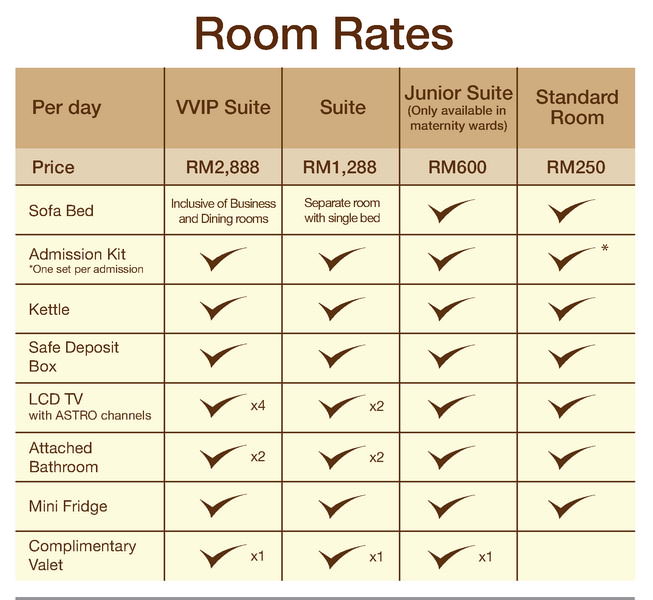Room Rate & Establishing the room rate in Hotel Front Office
A hotel has different types of rooms on the basis of room size, location, view, décor, furnishings, amenities, etc. Therefore the front office generally has more than one room rate category depending on the types of rooms.
Rack rate is the standard rate fixed by the front office management for a particular category of rooms. The rack rate is applicable for all guests except those who are authorized for any discounts. Although rack rates are important, guests may ask for and qualify for discount rates.
Some special room rate categories are:
- Corporate or commercial rate: the rate offered to companies that provide frequent business for the hotel or its

chain.
- Group rate: the rate offered to groups, meetings and conventions using the hotel for their functions.
- Promotional rate: the rate offered to guests during low occupancy periods to promote occupancy.
- Incentive rate: the rate offered to guests in affiliated organizations such as travel agents and airlines because of potential referral business. This rate may also be offered to group leaders, meeting planners, tour operators, and others capable of providing the hotel with additional room sales to promote future promote future business.
- Family rate: a rate reserved for families with children.
- Package plan rate: a rate that includes a guestroom in combination with other events, activities, or services such as breakfast, golf, tennis, etc.
- Internet rate: a special discounted rate that many hotels offer through their own websites. It is available to guests making their online reservations through hotel’s website.
- Distressed-inventory rate: a rate offered when a hotel projects or experiences low occupancy. This rate is implemented to help build occupancy.
- Complimentary rate: a room rate provided to special guests and/or important industry officials. The guest is not charged for the room during the stay but will have to pay for dining, telephone calls etc.
The management should consider various factors such as operating expenses, guest demand, market conditions, and related business issues when determining rack rates or discounted rates. Room rates are very important for a hotel’s success.
There are three methods of establishing room rates:
-
Market Condition Approach
In this method, the management looks at similar hotels in the area and sees what they are charging for the same product. These properties are often called the competitive set, which is made up of a number of properties in a market that are a property’s most important competition. The competition can be based on location, type, brand or other factors. According to this approach, the hotels will charge only what the market will accept. This information is available through various public domain sources and periodic blind calls to competing hotels. A blind call does not identify the hotel making the call and simply asks for availability and rates on specific dates
-
The Rule-of-Thumb Approach
This method sets the rate of a room at Rs.1/- for each Rs.1000/- of construction and furnishings cost per room assuming a 70 percent occupancy. For example, if the average construction cost of a hotel room is Rs.80000/-, the average room rate will be Rs.80/- according to this method. The emphasis on the hotel’s construction cost fails to consider the effects of inflation. It also fails to consider the contribution of other facilities and services towards the hotel’s desired profits.
The rule-of-thumb approach should also consider the hotel’s actual occupancy level instead of a fixed 70 percent occupancy.
-
Hubbart Formula Approach
It is a bottom-up approach to pricing rooms. This approach considers operating costs, desired profits, and expected number of rooms sold to determine the average rate per room. It is considered a bottom-up approach because its initial item – net income (profit) – appears at the bottom of the income statement. The second item – income taxes – is the second item from the bottom of the income statement, and so on. The Hubbart Formula approach involves the following eight steps:
- Calculate the hotel’s desired profit by multiplying the desired rate of return (ROI) by the owner’s investment.
- Calculate pretax profits by dividing desired profit (Step 1) by 1 minus the hotel’s tax rate.
3.Calculate fixed charges and management fees. This calculation includes estimated depreciation, interest expense, property taxes, insurance, building mortgage, land, rent and management fees.
4.Calculate undistributed operating expenses. This calculation includes estimating expenses for the following categories – administrative and general, information technology, human resources, transportation, marketing, property operation and maintenance, and energy costs.
5.Estimate non-room operated department income or loss, that is, food and beverage department income or loss, telecommunications department income or loss and so on.
6.Calculate the required rooms department income. The sum of pretax profits (Step 2), fixed charges and management fees (Step 3), undistributed operating expenses (Step 4), and other operated department income (Step 5) equals the required rooms department income.
7.Determine the rooms department revenue. The required rooms department income (Step 6), plus rooms department direct expenses of payroll and related expenses, plus other direct operating expenses equals the required rooms department revenue.
8.Calculate the average room rate by dividing rooms department revenue by the expected number of rooms to be sold.
Example
Holiday Inn, a 200 room property, is projected to cost Rs.9900000/- inclusive of land, building, equipment and furniture. An additional Rs.100000/- is needed for working capital, bringing the total cost of construction and opening to Rs.10000000/-. The hotel is financed with a loan of Rs.7500000/- at 12 percent annual interest and cash of Rs.2500000/- provided by the owners. The owners desire a 15 percent annual return on their investment. A 75 percent occupancy is estimated. Thus 54750 rooms will be sold during the year (200 x 0.75 x 365). The hotel’s income tax rate is 40 percent and additional expenses are estimated as follows:
Property tax expenses Rs.250000/-
Insurance expenses Rs.50000/-
Depreciation expenses Rs.300000/-
Administrative and general expenses Rs.300000/-
Data processing expenses Rs.120000/-
Human resources expenses Rs.80000/-
Transportation expenses Rs.40000/-
Marketing expenses Rs.200000/-
Property operation and maintenance Rs.200000/-
Energy and related expenses Rs.300000/-
The other operated departments’ income (losses) are estimated as follows:
Food and beverage department Rs.150000/-
Telecommunications department Rs.50000/-
Rentals and other departments Rs.100000/-
The rooms department estimates direct operating expenses to be Rs.10/- per occupied room.
The Hubbart Formula is very useful in setting target average rates.
| Item | Calculation | Amount | |
| Desired Net Income | Desired Profit = Owner’s Investment X ROI | ||
| 2500000 x 0.15 = 375000 | |||
| Pretax Income = Net Income / 1 – T | |||
| Pretax Income =375000 / 1 – 0.4 | 625000 | ||
| Plus: Interest Expense | Interest Expense = Principal x interest rate | ||
| 7500000 x 0.12 | + | 900000 | |
| Income needed before interest expense ans taxes | = | 1525000 | |
| Plus: Estimated Depreciation, property taxes and insurance | + | 600000 | |
| Income before fixed charges | = | 2125000 | |
| Plus: Undistributed operating expense | + | 1240000 | |
| Required operated departments income | = | 3365000 | |
| Departmental results excluding rooms | |||
| Less: Food and Beverage department income | – | 150000 | |
| Rentals and other department income | – | 100000 | |
| Plus: Telephone Department Loss | + | 50000 | |
| Rooms department income | 3165000 | ||
| Plus: Rooms Department direct expense | 54750 X Rs.10/- | + | 547500 |
| Rooms Revenue | = | 3712500 | |
| Number of Rooms Sold | ÷ | 54750 | |
| Required average room rate | = | 67.81 |





